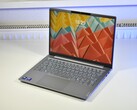Most laptop users know the ThinkPad brand and the immediately know they are dealing with business laptops. However, Lenovo also has a product line called ThinkBook, which is sitting right between laptops for private customers as well as business devices and they are primarily designed for small of medium-sized businesses. We just recently tested the two current 14-inch versions ThinkBook 14 G8 as well as the ThinkPad E14 G7, which are also similarly priced and equipped with the Core Ultra 7 255H and the Arc Graphics 140T.
If you look at the chassis including maintenance options, ports and the keyboard, the two devices are not that far apart. Both use an aluminum lid with a plastic base unit, even though the ThinkPad can also be ordered with an aluminum base unit. The biggest difference is the design, because the ThinkBook looks a bit fresher with its silver chassis. Both devices offer two slots for memory and SSDs each as well as a sufficient number of USB ports (including Thunderbolt 4). However, only the ThinkBook is equipped with a card reader. The keyboards are also very similar with a slight advantage for the ThinkPad, but the difference is not huge.
The ThinkPad E14 G7 clearly stands out in terms of display, because our review unit was equipped with the new optional 2.8K IPS screen with 120 Hz, which is superior to the default IPS screen of the ThinkBook 14 (less than 300 nits, 1080p, 60 Hz, low color gamut) in every way. Despite the better screen, the ThinkPad also manages better battery runtimes, but this is also a result of the larger battery (64 vs. 45 Wh).
| Lenovo ThinkPad E14 G7-21SYS00H00 Arc 140T, Ultra 7 255H, SK Hynix PVC10 HFS001TEM4X169N | Lenovo ThinkBook 14 Gen 8 21SJ007SGE Arc 140T, Ultra 7 255H, Western Digital PCSN5000S SDEPMSJ-1T00-1101 | |
|---|---|---|
| Display | -42% | |
| Display P3 Coverage | 72.2 | 41.5 -43% |
| sRGB Coverage | 100 | 60.3 -40% |
| AdobeRGB 1998 Coverage | 73.7 | 42.9 -42% |
| Response Times | 20% | |
| Response Time Grey 50% / Grey 80% * | 32.7 ? | 19.3 ? 41% |
| Response Time Black / White * | 15.7 ? | 15.8 ? -1% |
| PWM Frequency | ||
| Screen | -138% | |
| Brightness middle | 389 | 271 -30% |
| Brightness | 363 | 276 -24% |
| Brightness Distribution | 89 | 89 0% |
| Black Level * | 0.24 | 0.29 -21% |
| Contrast | 1621 | 934 -42% |
| Colorchecker dE 2000 * | 1.7 | 6.4 -276% |
| Colorchecker dE 2000 max. * | 3.5 | 20.7 -491% |
| Colorchecker dE 2000 calibrated * | 1.2 | 5.1 -325% |
| Greyscale dE 2000 * | 2.8 | 3.6 -29% |
| Gamma | 2.17 101% | 1.99 111% |
| CCT | 6572 99% | 6576 99% |
| Battery Runtime | ||
| WiFi v1.3 | 728 | 435 -40% |
| Total Average (Program / Settings) | -50% /
-91% |
* ... smaller is better
When it comes to the pure CPU performance of the Core Ultra 7 255H, the ThinkBook 14 has the advantage thanks to higher power limits (50/38 Watts vs. 45/28 Watts) both in short-term as well as long-term load scenarios. The graphics performance on our ThinkPad unit suffers from the single-channel memory configuration, but this can easily be fixed with a second memory module if required. The higher performance of the ThinkBook 14 does result in slightly louder fan noise under load though.
All in all, Lenovo offers very similar devices. The ThinkBook 14 looks a bit nicer and offers more CPU power, while the ThinkPad E14 has a small advantage in terms of chassis (if you take the aluminum base unit) and it also stays quieter and manages longer battery runtimes. The biggest advantage, however, is the 120 Hz screen. If you often use the internal screen and do not only use it connected to an external screen, the ThinkPad E14 G7 is clearly the better choice.
Please see our comprehensive reviews of the ThinkPad E14 G7 as well as ThinkBook 14 G8 for more information including benchmarks.



















